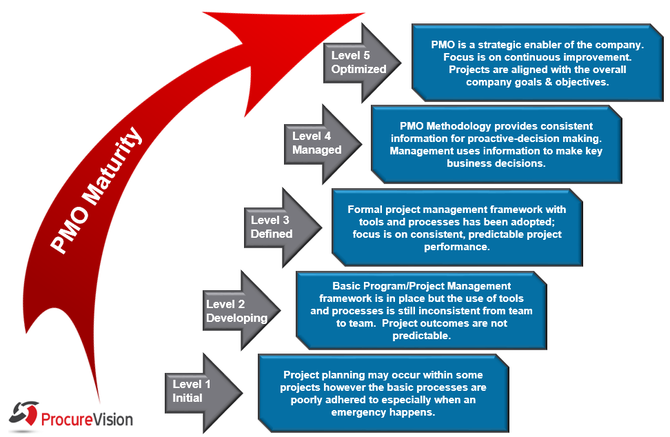 So your organization or department has identified an area for improvement – great! A team is assigned to tackle the challenge – fantastic! Now, how can you make sure that the team will achieve results? A common pitfall of projects is a scope that is either ill-defined or vague or alternately, that is too broad and all-encompassing. So how can you prevent this? The key to success is in the set-up. It’s all about the planning.
It is after these three steps that the project team and stakeholders will need to determine whether the “case for the project” is strong enough to be worthwhile, whether the resources and time required are manageable, and whether the vision or the future state successes are clear and measurable. As the project plan, timeline and associated resources are being developed, you have the opportunity to make sure that the vision and objectives are turned into realistic tactics that can be executed. This is the time when a large scope should be turned into sub-projects or a program with multiple projects; this is the time when an unclear scope becomes clear by defining what is in scope, what success looks like, versus what is not in scope and what is not going to be tackled. Remember, a critical element of a project’s success, is making sure that the team sees and feels that they are making progress. It is better to have sub-teams and sub-projects that have clear objectives that roll up to a program or alternately, that you have clear project phases with clear milestones/results, than a massive team with overwhelming project objectives that cannot figure out how to tactically make progress. And what do you do if your project has already started and your team is struggling with an unclear or overwhelming scope? It may be time to take a step back, re-evaluate and determine what needs to change to allow the project and team to continue productively. It may be time to refine or clarify the end-state, redefine what is “in” and what is “out” of scope and/or possibly add sub-teams and/or sub-projects to make the scope manageable again. It is better to take corrective actions, at any point in a project, than continue working with a discouraged team, an ineffective and possibly costly project, and unlikely odds of achieving success. What methods or tactics have helped your team manage scope?
0 Comments
 Our comprehensive PMO Framework covers the project lifecycle in 4 phases: Concept, Initiation, Delivery and Close. Having a clear Framework, with a standard methodology, process and tools, is critical to seeing a project successfully through to the end. Just because a project has realized its expected outcomes or results, the project is not yet quite over! The final project phase in our PMO Framework is the Close Phase. Don’t miss the opportunity to dot the I’s and cross the T’s…there is tremendous value in learning from your project successes and mishaps. Below, are the key activities we recommend occur during the Close Phase of your project. PM Checklist for the Close Phase:
Often overlooked, the Close phase of a project is critical to making sure all activities are completed and documented. Don’t miss the opportunity to bring your team and stakeholders together to learn from the project experience. And don’t forget to celebrate a project well planned and executed! What do you recommend occur during the close phase of a project? Do your project teams perform a “Lessons Learned” exercise?
 Our comprehensive PMO Framework covers the project lifecycle in 4 phases: Concept, Initiation, Delivery and Close. Having a clear Framework, with a standard methodology, process and tools, is critical to seeing a project successfully through to the end. The “business” of each project happens during this, the third phase of a project: the Delivery phase. It is during this phase that the actual project outcomes/expectations are created. In other words, this is the build phase of a project. Whether your project follows an Agile approach or a Waterfall approach, the following PM Checklist applies to you. See the PM Checklist for the Delivery Phase below:
Delivery is the operational part of the project where you execute on the work done in prior phases. Because this phase is often the longest part of your project, the activities listed above will need to be executed repeatedly in order to effectively manage the project. Please share your most critical tasks during the Delivery Phase of a project.
 A comprehensive PMO Framework is critical to seeing a project successfully through; a Framework we have used with clients includes 4 phases: Concept, Initiation, Delivery and Close. The initiation phase, the second of four phases, is critical because it is the phase in which you set yourself up for success! You finalize your goals, your team, your schedule and budget. In order to make sure you don’t miss any key activities during this phase, we have provided you with our PM Checklist below. Initiation Phase:
The activities undertaken during the Initiation phase ensure that you and your team are set up to succeed; you will confirm and finalize your goals and determine how you will achieve them. This phase prepares you to launch your project with a realistic timeline and budget. Are there any additional steps or suggestions you have for activities during the initiation phase?
 A comprehensive PMO Framework is critical to guide a project successfully through its lifecycle, from beginning to end. A PMO Framework we have used with clients has 4 project phases: Concept, Initiation, Delivery and Close. Having a clear project methodology, processes, and tools and templates enable project managers to guide their teams through the project phases. An easy and frequently used PM tool is their Checklist. They can refer to this tool many times during the day to make sure they are doing all the critical work needed during the project phase in which they find themselves. Key project activities during the first phase of a project, Concept Phase, are listed in our Project Management Checklist below. Concept Phase:
Although the Concept Phase involves a lot of work, it is worth spending the time and effort and is critical to setting your project up for success. Are there any other activities you recommend in the first phase of a project?
There are significant benefits to periodically assessing the maturity of your PMO and no shortage of maturity matrices to compare yourself to. Our PMO Maturity Matrix features five levels: Initial, Developing, Defined, Managed and Optimized. When determining the maturity of a PMO we look specifically at four main areas: Project/Program Governance, People, Processes and Tools.
Once you have determined what level of maturity your PMO is performing at, you may identify areas or aspects that are lagging – for instance you may be collecting standard project data monthly onto a paper template, but would benefit by developing a database to collect project data and metrics so all have access and can compare projects on-line, real-time. Or maybe you identify areas that can mature to the next level, for instance you have an IT PMO but the entire organizations’ projects could benefit from its structure and methodology! Work with your PMO, project governance team and project managers to determine which efforts would benefit your organization the most and prioritize the efforts creating a roadmap for near-term, mid-term and long-term accomplishments. Most organizations never get to the highest level of PMO maturity; the effort and cost to get there outweighs the benefits to some. Either way, a review of your PMO’s maturity will give you insights into what is working well and what could benefit from improvement. A Roadmap can help your organization keep its eye on the ball and reap the rewards of an increasingly mature PMO. Does your organization periodically assess the maturity of your PMO? Do you have a PMO Roadmap for continuous improvement?
|
ABOUTProcureVision, LLC is a management consulting company that enables our client's business success through the optimization of their people, process and technology. We provide creative, customized and completely implementable solutions. Archives
April 2018
Categories
All
|









 RSS Feed
RSS Feed